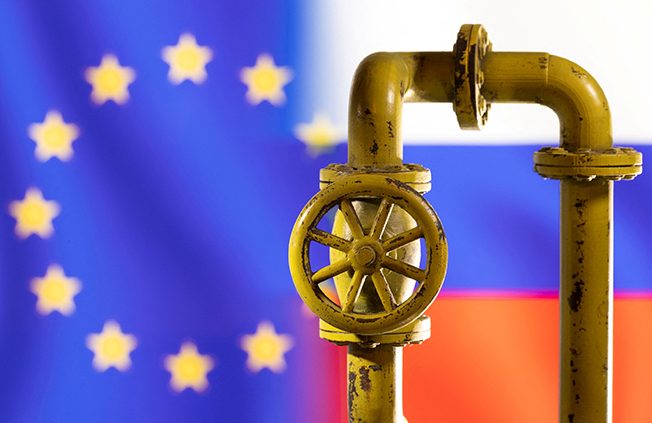The Nord Stream 1 pipeline that transports Russian gas to Germany will undergo further maintenance, Gazprom said on Friday after scrapping a Saturday deadline to resume flows, deepening Europe’s difficulties in securing fuel.
Gazprom was already undergoing maintenance from Aug. 31-Sept. 2, prompting concerns about supply to Europe ahead of the onset of winter if the outage was extended.
Russia slashed flows through the pipeline to 40 per cent of capacity in June and to 20 per cent in July.
It has also cut off supply to several European countries such as Bulgaria, Denmark, Finland, the Netherlands and Poland, and reduced flows via other pipelines since launching what Moscow calls its “special military operation” in Ukraine.
The following outlines Europe’s options.
WHAT ARE THE MAIN ROUTES FOR RUSSIAN GAS TO EUROPE?
Russia typically supplies about 40 per cent of Europe’s natural gas, mostly by pipeline. Deliveries last year were around 155 billion cubic metres (bcm).
Via Ukraine, the gas goes mainly to Austria, Italy, Slovakia and other east European states. Ukraine has closed the Sokhranovka transit pipeline that runs through Russian-occupied territory in the east of the country.
European countries have been seeking to find alternative supply, including some cut off by Russia after rejecting a demand they pay in roubles.
Others, including Germany, still need Russian gas and are trying to refill gas storage ahead of winter.
Alternative routes to Europe that do not go via Ukraine include the Yamal-Europe pipeline, which crosses Belarus and Poland to Germany.
The Yamal-Europe pipeline has a 33 billion cubic metre (bcm) capacity, around a sixth of Russian gas exports to Europe. Flows have been reversed to flow eastward between Poland and Germany since the start of this year.
Moscow has placed sanctions on the owner of the Polish part of the Yamal-Europe pipeline. However, Poland can manage without reverse gas flow on the Yamal pipeline, its climate minister has said.
On Nord Stream 1, the Kremlin has blamed Western sanctions for a delay in the return of equipment sent for maintenance to Canada.
EUROPE’S ALTERNATIVE SUPPLIERS?
Some countries have alternative supply options and Europe’s gas network is linked up so supplies can be shared, although the global gas market was tight even before the Ukraine crisis.
Germany, Europe’s biggest consumer of Russian gas, which has halted certification of the new Nord Stream 2 gas pipeline from Russia because of the Ukraine war, could import from Britain, Denmark, Norway and the Netherlands via pipelines.
Norway, Europe’s second biggest gas supplier behind Russia, has been raising production to help the European Union towards its target of ending reliance on Russian fossil fuels by 2027.
Britain’s Centrica (CNA.L) has signed a deal with Norway’s Equinor (EQNR.OL) for extra supply for the next three winters. Britain does not rely on Russian gas and can also export to Europe via pipelines.
Southern Europe can receive Azeri gas via the Trans Adriatic Pipeline to Italy and the Trans-Anatolian Natural Gas Pipeline (TANAP) through Turkey.
The United States has said it can supply 15 bcm of liquefied natural gas (LNG) to the European Union this year.
But US LNG plants are producing at full capacity and a blast at a major LNG export terminal in Texas will keep it idle until late November.
Europe’s LNG terminals also have limited capacity for extra imports, although some countries say they are seeking ways to expand imports and storage.
Germany is among those who want to build new LNG terminals. It plans to build two in just two years.
Poland, which relies on Russia for about 50 per cent of its gas consumption or around 10 bcm, has said it can source gas via two links with Germany. A new pipeline allowing up to 10 bcm of gas per year to flow between Poland and Norway will be opened in October. A new gas link between Poland and Slovakia was also commissioned last week.
Spain wants to revive a project to build a third gas connection through the Pyrennes mountains but France has said new LNG terminals, which can be made to float, would be a quicker and cheaper option than a new pipeline.
OTHER OPTIONS TO COPE WITH A GAS SUPPLY CRUNCH?
Several nations can seek to fill any gap in energy supplies by turning to electricity imports via interconnectors from their neighbours or by boosting power generation from nuclear, renewables, hydropower or coal.
Nuclear availability is falling in Belgium, Britain, France and Germany with plants facing outages as they age, are decommissioned or phased out. Hydro levels have been falling this summer due to low rainfall and a heatwave.
Europe has been trying to shift from coal to meet climate targets but some plants have been switched back on since mid-2021 because of surging gas prices.
Energy ministers agreed that all EU countries should voluntarily cut gas use by 15 per cent from August to March, compared with their average annual use during 2017-2021 and introduced EU-wide targets for refilling gas storage.
Germany has triggered stage two of its three-stage emergency gas plan and urged businesses and consumers to save gas to avoid forced rationing.
The Dutch energy minister has said its Groningen field could be called upon to help neighbouring countries in the event of a complete cut-off in Russian supply but ramping up production would risk causing earthquakes.

